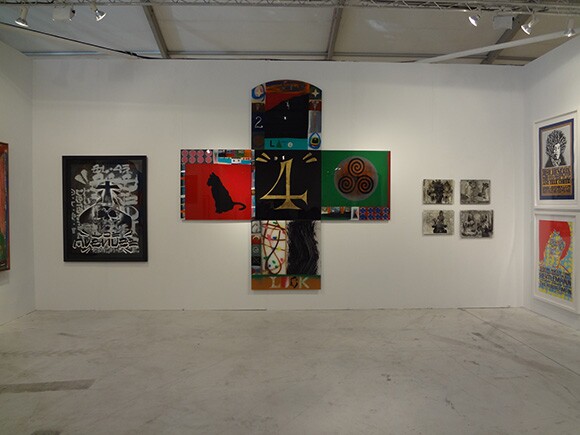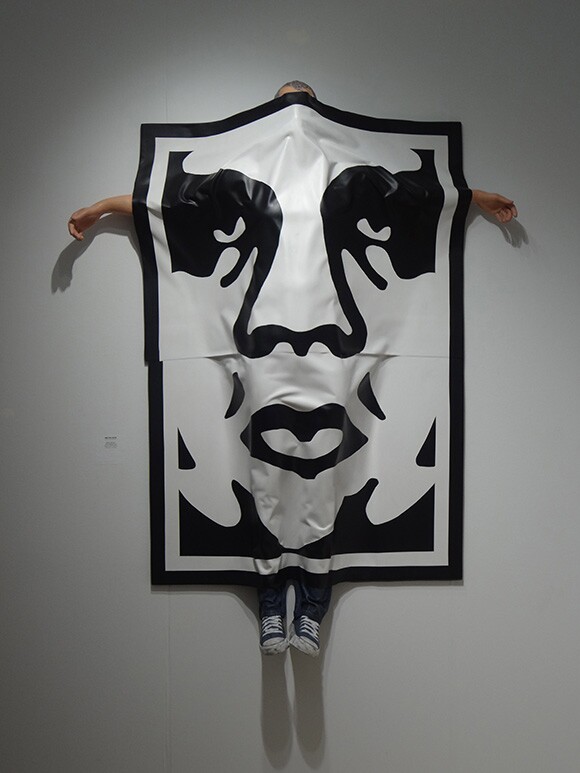Art Basel: It's Wonderfully Terrible

OP-Art: Opinions and editorials about art, institutions, and the relationship between them.
The phenomenon of the Miami edition of Art Basel is nothing short of remarkable, humbling, and frustrating. An avalanche of gallerists, collectors, artists, and art aficionados descend upon the beach town for a full week to buy, gawk, and socialize in a fish bowl atmosphere. From the main fair that is Art Basel held at the convention center to the auxiliary fairs around the city, there were a host of Southern California artists and galleries that made the West Coast proud amidst an exasperating cache of celebrity and charlatans.
Amidst the shiny objects and fun of Art Basel, you can't help but suggest that art needs to be political in the 21st century given the recent events on the streets of America. One of the most successful happenings involved a group of committed individuals that marched onto the freeway and shut down traffic as part of a national movement against police violence called "Shut It Down." The protesters brought attention to the string of police brutality and killings against unarmed minorities, including a local Miami resident and artist Israel Hernandez who died last year at the hands of the police. Despite the glitz and glam, these protests were reminders that art needs to do so much more than just sit in a booth.

If you hate reducing art to finances, then read no further because Art Basel is the Wild West. The unregulated tactics involved in blue chip galleries and the exorbitant amount of wealth is difficult to absorb. A couple of collectors from Manhattan were self-deprecating their status as collectors during a brief interview. After all, their $100,000 purchase is considered chump change in this context. They are not real collectors but were excited to follow their friends around -- who know what they are doing. They in turn follow others in an endless repletion of the pattern. The resultant obfuscation leads only to a sad state of affairs where no one feels like they belong.
Engaging an audience is important but the preponderance of relational aesthetics was paramount, an unfortunate atmosphere that hooks visitors through an abundance of veneer over content. Yet there is hope in these rough waters. The search through the parades of gallery booths can be quite fun. Artists and galleries don't send their worst work to fairs. Instead it's a time to bring the very best. As a visitor you have a special opportunity to see a lot of it in a short amount of time. This experience can be somewhat like drinking from a fire hose. However, if you're deliberate -- there are gems to be had and much you can learn about your own aesthetic.

Chinatown's Coagula Curatorial at the Context Art Miami fair was one of these environments with an actual show entitled "California Locos." The large space featured works by Chaz Bojorquez, Dave Tourjé, John Van Hammersveld, Norton Wisdom, and Gary Wong. By bringing these artists to Miami, the gallery has the potential to place them in a larger conversation with collectors and art institutions. Tourjé's was taken aback by the attentiveness to the show. From his interactions with visitors, he could see a significant interest in the surf, skate, and street scene internationally, which he found refreshing because he feels this culture is often taken for granted in southern California.
The opportunity to connect with colleagues and collectors from around the globe is one of the great benefits for artists and galleries in Basel. Miami has become that location where these worlds coalesce annually. Los Angeles artist Desire Obtain Cherish who exhibited with Unix Gallery emphasized the importance for him to connect with international clients. Miami has become the one location where he consistently touches base with his collectors. They expect to see him and receive updates about where the work is going, relationships build and new ones are established that enable him to create more work.


Interestingly, the fairs have also become a type of peer review for galleries and have come to represent a level of quality. While blue chip spaces in Los Angeles like Gagosian Gallery, Blum and Poe, Honor Fraser and Regen Projects have booths at the main Art Basel fair; there were perhaps more exciting and adventurous projects at Scope, Aqua, and Art Miami each having a unique quality that characterized them. One can almost begin to determine the direction of a gallery based upon their fair record.
The Scope Art Faircertainly catered to the hip crowd with its list of exhibitors, which included booths by Juxtapoz Magazine and Red Bull. Despite this, the fair featured stimulating works from southern California galleries including C.A.V.E. Gallery,Thinkspace, and the Phone Booth Gallery. An individual work from L.A.-based Ryan McCann at Inner State Gallery garnered a lot of attention because it lampooned street artist Shepard Fairey through a life size replica of the artist that was mounted on the wall, crucified via one of his infamous posters.
Transitioning to Pulse Contemporary Art Fair felt much more refined compared to the youthfulness of Scope. A welcomed change of pace and atmosphere, Shoshana Wayne's space was one of the highlights that exhibited Southern California talent Phil Argent and his "Untitled" 2014 painting. Argent's images start where hard edge meets the digital age and are akin to computer graphics melting into an icy blend of colors. A frenzied yet controlled image, it recesses into an infinite space.


As we move further from the fairs, the streets of the Wynwood Arts District are host to hundreds of murals that are facilitated in the middle of a historically depressed neighborhood of Miami. Established in 2009 by Tony Goldman and Jeffrey Deitch -- it's part artistic and part real estate development. The carefully curated murals are a wonderful contrast to the fairs and price tags. Yet even this world has big money behind it. Where else can you have lunch or dinner in a Goldman owned restaurant while taking in a calculated and carefully orchestrated group of street art murals? Outside this circle, many more works (legal and illegal) dot the perimeters of the neighborhood. In fact, the performative aspect of seeing so many talented artists working outside is really unique, an ongoing act throughout the week. A Madmax scenario, the smell of spray paint wafts through each street and has the staunchest aficionado of gallery work smile at all the creative activity.
Art Basel is certainly a behemoth, a wonderfully terrible one. Upon first glance it would appear the fair is not so much about art as it's a measuring stick of where you stack up in the art world but there is so much more to this week of art. Art fairs have become the new academy and Art Basel is the contemporary Ã?cole des Beaux-Arts. Fairs have begun to set standards and rules that gallerists, artists, and collectors alike must jump through with hopes of success. It's a new type art mecca that is perhaps not the ideal context for viewing art but that's not why it was built.
Dig this story? Sign up for our newsletter to get unique arts & culture stories and videos from across Southern California in your inbox. Also, follow Artbound on Facebook, Twitter, and Youtube.